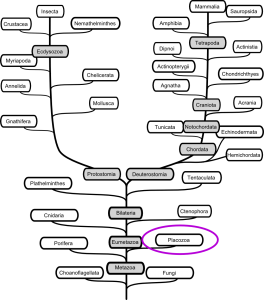Moved to Trichoplax neuropeptide
Category Archives: Endocrinology
Beta-cell development and genetics
Two reviews in Trends in Endocrinology and Metabolism (DOI: http://dx.doi.org/10.1016/j.tem.2014.05.001 and DOI: http://dx.doi.org/10.1016/j.tem.2014.03.013) address the development and the pathogenesis of pancreatic β-cells. Conrad, Stein and Hunter describe the transcription factors in mice and man which lead to β-cell genesis while Thomsem and Gloyn focus their attention to malfunction leading diabetes mellitus. Both reviews together show the actual status in β-cell research.
Neurosecretory cells in Trichoplax
Trichoplax adhaerens are among the earlier animal precursor on the same lines as sponges (porifera)
In a paper in Current Biology (http://dx.doi.org/10.1016/j.cub.2014.05.046) Smith et al. show that this archaic organism has six cell types one of them a neurosecretory cell. This is remarkable since it would be the earliest example of neuroscretory cells. It would also show that neurosecretory cells are one of the primordial cells types in animals before the nerve system became apparent. A FMRF-amide has been suspected in the genome of Trichoplax and its expression is measured with an antibody against FMRF-amides.
We have analyzed the situation further: In the whole genome of Trichoplax was searched for frmfgkr (gkr was added since that would most probably be result in a processed frmf-amide.) A perfect homology was not found. There was , however, one peptide sequence which would give rise to a oligopeptide precursor with more than one peptide-amide (XP_002117813.1). Other protein would fullfil the requirements for a peptide precursor much less stringently:

There are several repeats of nsxsxqqgipsitf (x for variable amino acids) which are separated by gkr as neuropeptides should. These repeats are underlined, the gkr motifs are coulored in red, the homologues sequences are yellow highlighted. The N-terminal peptide has a RR motif in front which would fit a prohormone convertase 2. You may read in Hormon und Hormonsystem about maturation of hormones and neuropeptides.
This sequence is by all criteria a neuropeptde precursor. It is different from FRMF-amides and it is questionable whether the antiserum described in the article would react to it.
Reviews on GPCR
In the Journal of Molecular Endocrinolgy (Vol 52. No 3) there are several reviews on the evolution of G-protein coupled receptors: Secretin, CRH, Kisspeptin, Ghrelin, melanocortin, somatostatin/urotesin, and the 26 RFamide (GPR103). These reviews are obviously freely available.
I read them only cursory, however, I found very interesting relations of CRH from vertebrates, and diuretic hormones of insects which are going into the English version of the textbook on endocrinology.
